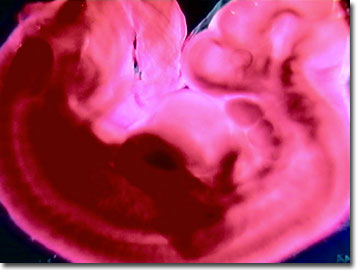Darkfield Digital Image Gallery
Pig Embryo
As one of the first dissection animals experienced in comparative anatomy laboratory, fetal or embryonic pigs are very well studied because their development and organ systems reasonably parallel human development. Pig embryos are also playing a role in reproductive biology whether used in embryo transfers for advanced livestock breeding and production, or for studying techniques for improving human fertility and birthing success.

View a second image of a pig embryo.
Although domestic pigs (Sus scrofa) are not closely related to humans, it has been long known by swine producers, veterinarians, and physicians that similarities must exist between the immune systems of both mammalian species since each can act as a disease vector for the other. In fact, one of the largest pandemic disease outbreaks to ever hit the human race, the flu epidemic of 1918, was most likely a swine flu transferred from the barnyard animals to humans, probably by respiratory fluids. If humans visit modern, relatively aseptic corporate swine production facilities, they must first shower and don sanitized shoes and clothing and not enter if they have a cold or virus, in order to not infect the hogs.
Pigs are notoriously omnivorous and eat a large variety of plants, animals, and carrion. Given a bad rap because they like to wallow in mud to cool off and moisturize their skin, pigs tend to be much cleaner than most animals. Feral pigs root and dig in the ground, feeding on roots, and in some areas of the world, cause ecological damage by destroying rare habitats and eating endangered flora and fauna. Feral pigs were accidentally introduced throughout the world by fifteenth century explorers that carried live hogs aboard ships as an easily maintained (they eat garbage and scraps), renewable protein source for the crew. With a lifespan of 9 to 15 years and reaching maturity as early as 8 months of age, an adult sow can weigh up to 450 pounds, giving birth to an average of 8 to 12 piglets (but as many as 30). The gestation period for pigs is about 114 days, or a little more than half as long as that of humans.
In terms of intelligence, pigs are probably the most intelligent of the domesticated animals, perhaps smarter than even most dogs. In the order Artiodactyla, pigs are considered even-toed ungulates and are placed in the family Suidae. Under domestication, many breeds of the S. scrofa have been developed and have fallen in and out of production favor based on the meat and leather market demands. Promoted as the "other white meat", pork, if not cooked properly, can transmit trichinosis to humans via the parasitic nematode Trichinella spiralis.
Contributing Authors
Cynthia D. Kelly, Thomas J. Fellers and Michael W. Davidson - National High Magnetic Field Laboratory, 1800 East Paul Dirac Dr., The Florida State University, Tallahassee, Florida, 32310.
BACK TO THE DARKFIELD IMAGE GALLERY
BACK TO THE DIGITAL IMAGE GALLERIES
Questions or comments? Send us an email.
© 1995-2025 by Michael W. Davidson and The Florida State University. All Rights Reserved. No images, graphics, software, scripts, or applets may be reproduced or used in any manner without permission from the copyright holders. Use of this website means you agree to all of the Legal Terms and Conditions set forth by the owners.
This website is maintained by our
Graphics & Web Programming Team
in collaboration with Optical Microscopy at the
National High Magnetic Field Laboratory.
Last Modification Friday, Nov 13, 2015 at 02:19 PM
Access Count Since September 17, 2002: 17218
Visit the website of our partner in introductory microscopy education:
|
|
